The ‘Volunteer State’ has a lot of environments for the hosting of Avian delights. The Appalachian mountain range, the Valley region, and even coastal areas are just a few geographical highlights that help to ensure a diverse collection of birds enjoy spending seasons and even the whole year in Tennessee. Today we’ll explore some of examples of the local winged wildlife and give you information that you can use to feed and find these beauties as well as provide you with some hotspots where you spend some time away from the house doing what you love.
Watching those birds!
Let’s get this show started and begin our exploration of the backyard birds of Tennessee!
3 Categories – 423 Birds
Tennessee is home to approximately 423 Avian species and this is good news for budding or veteran birdwatchers. There’s always a new bird just around the corner and with a little coaxing you might just earn a new regular visitor to your own backyard. This is too many birds to detail in the space we have and so we’ll be giving you 5 examples of birds that you can see sectioned into the seasons when you can see them. We’ll divide those seasons as follows:
- Year-round Resident birds
- Birds of Spring, Summer, and Early Fall
- Fall and Winter Birds
With each entry you’ll get measurements as well as descriptions of each bird. In addition, we’ll tell you what they like to eat in feeders and where they like to hang out so that you can prepare in advance to lure them in or simply to go to where they are most likely to be hiding. While the lure-foods aren’t a guarantee the suggestions are solid and can increase your chances of getting the attentions of various birds that you would like to see up close, so be sure to take notes. Occasionally there is a gem or two in the ‘diet’ section that you won’t want to miss!
Tennessee’s Year-round Resident birds
Here we will showcase some birds who are year-round residents of the Volunteer state. These birds can be seen during any season so you will want to be sure to keep your eyes peeled. You don’t want to miss them! Watch for the following winged wonders the next time that you are out or sipping some tea on the porch:
- Red-bellied Woodpecker
- American Goldfinch
- Eastern Bluebird
- Carolina Chickadee
- American Robin
Red-bellied Woodpecker – Melanerpes carolinus

Coloration and Markings: The Red-bellied Woodpecker has a black back and wings, along with a short, perky tail, all decorated with stripes rather similar to a Zebras. White patches may sometimes be visible at the wingtips when this bird is in flight and they have a white breast and underbelly, with faint splotches of red throughout. Facially, this bird has a white face that often displays faint red splotching from its cheek to its long, straight black bill, and a distinctive red cap which travels all the way down to the back of the Woodpecker’s neck.
Size: This bird measures in at approximately 9.4 inches in length with a wingspan of 13 – 16.5 inches.
Habitat: Hardwoods such as Hickory or Oak will attract these birds to your yard, as these are trees which they favor in the woods. Don’t fret if you don’t have one of these trees, however, as these birds aren’t shy about visiting feeders if you’ve prepared in advance.
Diet: Suet and peanuts are good foodstuffs to stock up your feeder with for Red-bellied Woodpecker visits. They will also occasionally sample Black Oil Sunflower seeds and even raid Hummingbird feeders, so you have a lot of options with these birds.
American Goldfinch – Spinus tristis

Coloration and Markings: Mating season is when the male American Goldfinch looks his best, With a bright yellow back couples with black wings and a long, black tail, both of which are decorates with vertical white lines below the distinctive wingbar. The breast and underbelly are yellow as well, with white at the rump that extends under the tail, and facially these birds have a yellow face with a black cap from the forehead to it’s small, conical orange bill. Females are a duller yellow on the upper portions of the body and olive-green on the lower portions and in winter both genders go incognito, molting their feathers to replace them with brown plumage but dimly visible wingbars and those orange bills can still help you to identify them.
Size: These little guys measurein at 4.5 – 5.1 inches in length with wingspans of 7.5 to 8.7 inches.
Habitat: These birds love areas prone to flooding as well as fields with high grass. They also like orchards, gardens, and backyards, so stock those feeders and you might just lure an American Goldfinch to visit!
Diet: An easy bird to lure, simply load up the feeder with Black Oil Sunflower seeds and Nyjer and be sure to scatter some around the feeder’s base, as these birds prefer to ground forage.
Eastern Bluebird – Sialia sialis
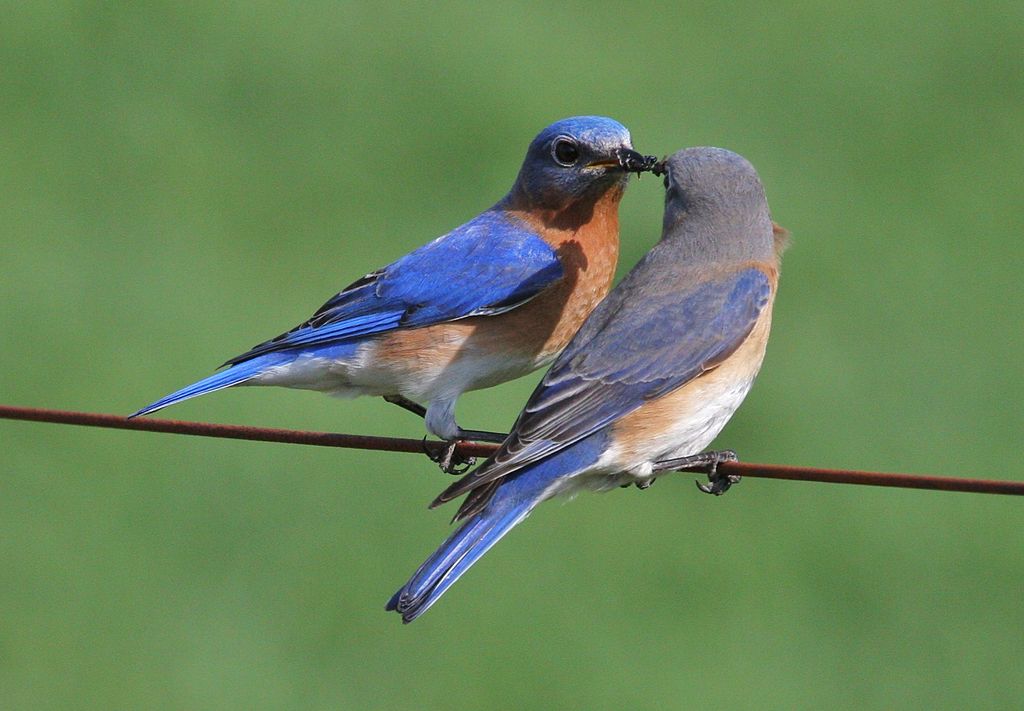
Coloration and Markings: The male Eastern Bluebirs has blue wings and back, with black on the wingtips and a small, blue tail with a little black edging. The breast and neck of this bird are a rusty-orange color which extends above the underbelly stopping just short of the rump. The underbelly and rump are white. Facially, this bird has a blue face with some gray skin showing around the eyes and a small, slightly curved black bill. Females have more subdued colors and appear grayish on the upper portions of their bodies.
Size: This bird measures in at 6.3 – 8.3 inches from tip to tail and has a wingspan of 9.8 to 12.6 inches.
Habitat: Meadows in the wild, golf-courses and backyards in the city, the Eastern Bluebird is not shy about visiting feeders in the slightest so be prepared.
Diet: Eastern Bluebirds eat mostly insects but they occasionally snack on berries (especially in the wintertime for extra calories). Add mealworms, dried crickets, and assorted dried or fresh berries for best results.
Carolina Chickadee – Poecile carolinensis
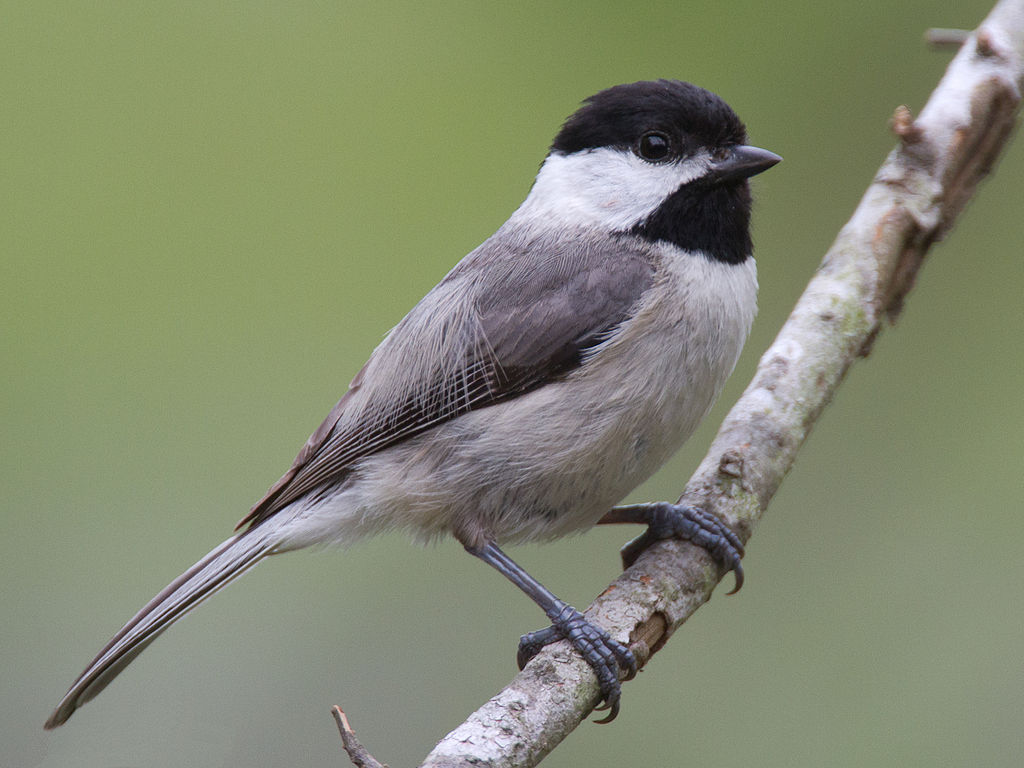
Coloration and Markings: The Carolina Chickadee has a gray back, wings, and tail with some black edging accenting their wing and tailfeathers. The breast and underbelly are snow-white and facially, this bird has a black ‘bib’ from the lower bill to the throat, a white face, and a large clack cap which goes across the head and is centered on the middle of the eye. They have tiny, conical black bills.
Size: The diminutive angels measure in at 3.9 – 4.7 inches in length with wingspans of 3.9 to 7.9 inches in length.
Habitat: When they are not deep in the forests these birds are spending time in parks and backyards, searching for feeders and other easy food sources.
Diet: Crushed peanuts, suet, and Black Oil Sunflower seeds are an easy selection that will tempt the Carolina Chickadee.
American Robin – Turdus migratorius
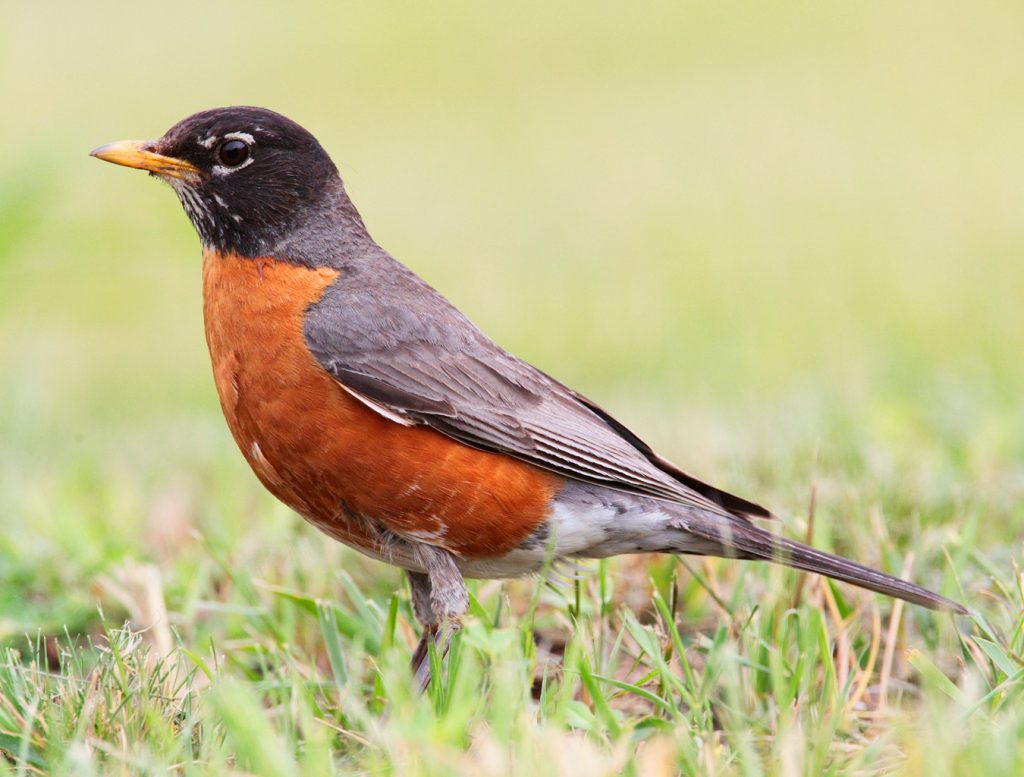
Coloration and Markings: The American Robin has a grayish-brown back, wings, and tail, with some white edging in the wing and tailfeathers. They have a lovely orange breast and lower belly with some white at the rump which underscores the tailfeathers. Facially, these birds have faces the same color as their upper bodies, though slightly richer, with some faint white outlining around the eyes and short, slightly curved yellow bills.
Size: This bird measures in at 7.9 – 11 inches in length with wingspans of approximately 12.2 to 15.6 inches.
Habitat: Gardens, pastures, or even hopping around in snow, the American Robin enjoys a diverse number of habitats and is not shy about visiting the suburbs. Stock your feeder with some food that they like and you might just make a new friend.
Diet: These birds are easy to please, simply keep it simple with ‘bugs and fruit’. Mealworms or dried crickets meet the first requirement and you can experiment on the latter although we can say with certainty that they do love chopped apples.
Tennessee’s Birds of Spring, Summer, and Early Fall
Spring is a vibrant time in Tennessee and a number of beautiful species come migrating in to enjoy it. With a little bit of planning you can have your ready and potentially host the following:
- Orchard Oriole
- Blue Grosbeak
- Barn Swallow
- European Starling
- Indigo Bunting
Orchard Oriole – Icterus spurius

Coloration and Markings: Orchard Orioles have simple but beautiful plumage. They have black backs and wings, though half of the shoulder will be a rich reddish brown, and vertical white striping may be seen on the mid and lower wing. They have medium-sized black tails which they like to fan out and their breast and underbelly is the same rich reddish-brown you see on the lower shoulder. Facially, these birds have black faces and throats with a black and silver bill. Females have no black on their bodies but are green and brown with visible wingbars.
Size: These birds measure in at 5.9 – 7.1 inches in length with wingspans of approximately 9.8 inches.
Habitat: These birds love open woodlands and are attracted to water as well, seen often at the edges of rivers and ponds. They especially love orchards and will not hesitate to visit feeders that have been stocked appropriately in anticipation of their visits.
Diet: These birds love insects and fruit and while mealworms and chopped up orange will work one trick that you can use is to add grape jelly to your feeder. Many people swear by it, give it a try and see for yourself!
Blue Grosbeak – Passerina caerulea
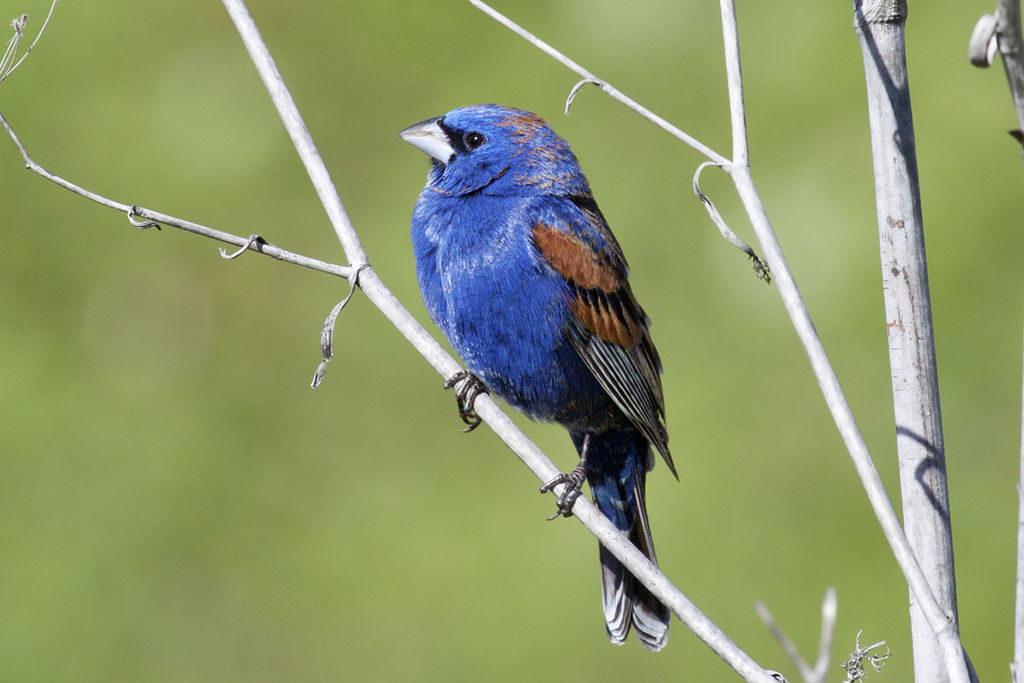
Coloration and Markings: The Blue Grosbeak is blue indeed, with a blue back, wings, and a medium sized blue tail. The wings have soft brown wingbars and there are some white tips on the wingfeathers closest to the body. The breast and underbelly of this bird are, you guessed it, blue! Facially, this birds has two breaks from the deep blue it is bathed in, those being a black half-mask that goes from the bill to just over the eyes and they have short, stout and curved silver bills.
Size: This bird measures in at 5.9 – 6.3 inches from head to tail with a wingspan of approximately 11 inches.
Habitat: These birds like anywhere with dense vegetation, so if there are shrubs and thickets then you might just spot one. They also like fields at the forest’s edge.
Diet: Blue Grosbeaks are a little shy about feeders though shrubs in your backyard will help to lure them. Millet and Black Oil Sunflower seeds are well-received by these birds.
Barn Swallow – Hirundo rustica
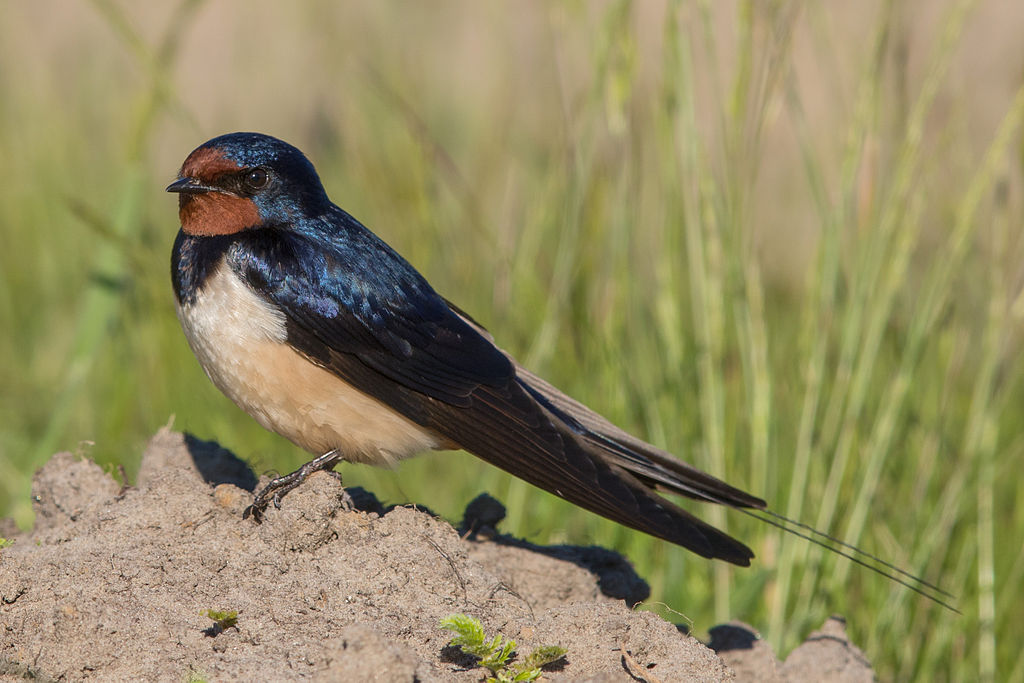
Coloration and Markings: Barn Swallows look like little superheros, with blue back, wings, and forked blue tails, and the blue extends into the upper breast in the form of two broad lines on opposing sides. This gives the look that this bird is wearing a blue cape. The underbelly and breast are a warm orange with some small bits of white barely visible just under the wings (and on the underside of the tail) and this orange extends up into the face, triangulating just over the sharp, short black bill. The rest of the upper head is blue, which extends down to the lower face to outline the cheeks, and the ‘superhero’ theme is completed with this birds diamond-shaped mask.
Size: These birds measure in at 5.9 – 7.5 inches in length with wingspans of 11.4 to 12.6 inches.
Habitat: Barn swallows love open areas, such as fields or meadows, and they are fond of water as well so you may often see them at the edge of a river or a pond if they area is open enough to make this bird feel comfortable.
Diet: While you can’t tempt their tummies with yummies you can still lure these birds to a feeder with crushed eggshells, which are believed to aid in digestion for Barn Swallows and some other birds. Give this a try, it works!
European Starling – Sturnus vulgaris
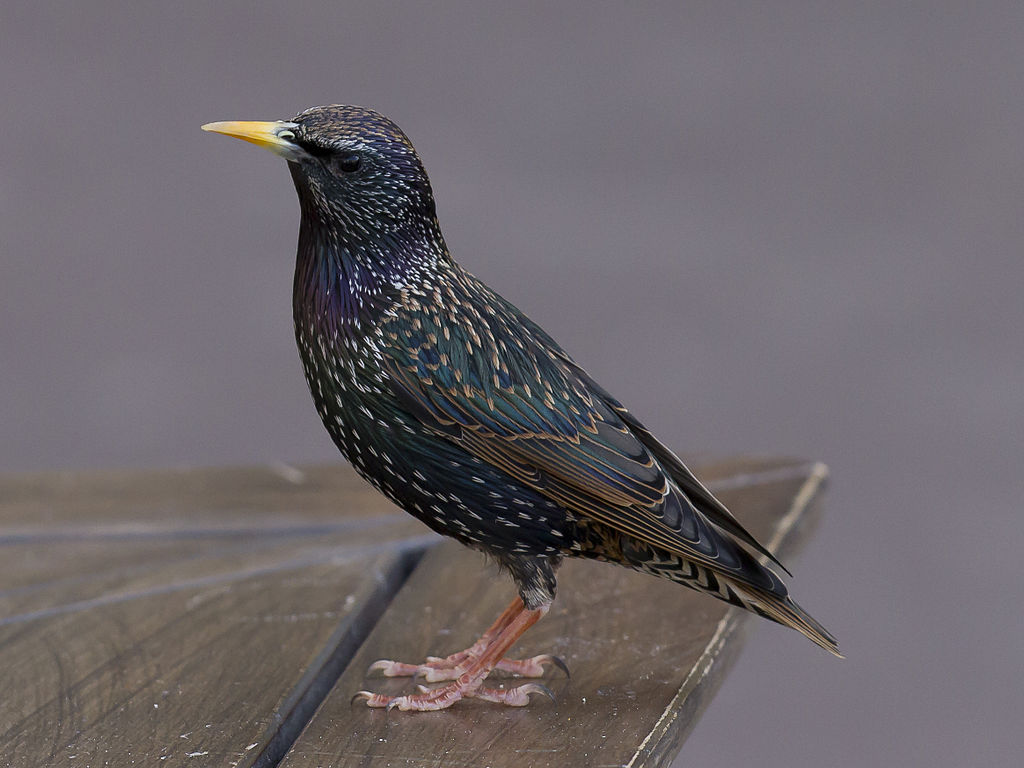
Coloration and Markings: The European Starling has two looks, depending on what season you catch a glimpse in. In the warm months, they are a purple-green color all over which is shiny and lovely to look on, though from a distance appears to be simply black. They have long, straight yellow bills and in the winter they shed their plumage to become brown Starlings with white spots!
Size: These birds measure 7.9 – 9.1 inches from head to tail, with wingspans of 12.2 to 15.8 inches.
Habitat: European Swallows were brought to America on purpose a very long time ago and as such, these birds are super-urbanized. Look for them around town on fences, telephone poles, and in your own backyard.
Diet: European Swallows have lived with us long enough that they will eat just about anything but they are particularly fond of grains. A little White Proso Millet will go a long way with these birds.
Indigo Bunting – Passerina cyanea

Coloration and Markings: Male Indigo Buntings are quite easy to identify, being a completely indigo blue on their back, wings, tail, and even their breast and underbelly. Their heads are the same color, slightly richer, with the only exception being their short, stout silver bills and a black marking which goes from the bill to barely at the front of the eye, where a curved eyeline is present which only appears in front of the eye, rather than completely around it. Females, by contrast, are brown with some streak marks on the breast and scattered touches of blue throughout the brown plumage and a white throat.
Size: These birds measure in at 4.7 – 5.1 inches in length with wingspans of 7.5 to 8.7 inches.
Habitat: These birds love brush and thickets, especially at the edges of forests but they will spend time just about anywhere that the vegetation is dense enough to make them feel like they can forage in safety.
Diet: Black Oil Sunflower seeds and Nyjer thistle will make the Indigo Bunting quite happy and possibly earn you some repeat visits.
Tennessee’s Fall and Winter Birds
Tennessee has fairly mild winters, often averaging around 40 degrees. There is a lot of snowfall at times but with mostly-mild temperatures there are a lot of birds out there just waiting to be spotted. Look for these birds during the wintertime:
- Hermit Thrush
- Fox Sparrow
- Yellow-rumped Warbler
- Dark-eyed Junco
- House Finch
Hermit Thrush – Catharus guttatus

Coloration and Markings: Hermit Thrushes have brown wings with some minute white edging on the wingfeathers and on their small, perky brown and red tails. These are plump-breasted birds, with distinct black spots on their white breasts which fade in color as they approach the completely-white underbelly. Facially, these birds have a white ‘bib’ from bill to throat which is bisected by the black spotting that has continued up from the breast. The rest of the face is brown with some minimal white outlining around the eye and short, sharp bills which are brown on the lower bill and black on the upper side.
Size: These Thrushes measure in at 5.5 – 7.1 inches from head to tail and have wingspans of 9.8 to 11.4 inches.
Habitat: These birds like to hang out at the forest’s edge and occasionally visit orchards.
Diet: While the Hermit Thrush does not typically visit feeders, if you have some fruiting vines or trees in your yard this may well lure them to visit. You might have some luck with chopped apple and dried fruits in the feeder but we can’t make anwy promises, as these birds are typically quite shy.
Fox Sparrow – Passerella iliaca
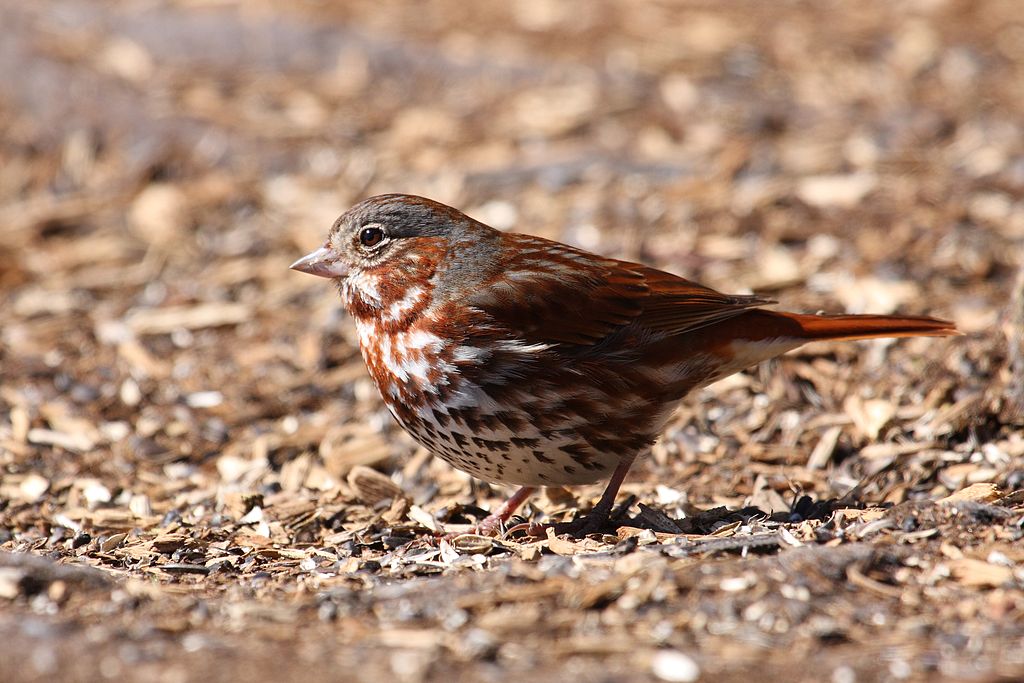
Coloration and Markings: While markings may vary from region to region, these birds are typically a reddish-brown on the wings, back, and short, perky tails (the undersides of which will be white), and they have a white, red-brown streaked breast and sides with the underbelly being pure white. Facially, these birds have brown and white chins with brown on their lower-face, stopping at a white mustache-line which stops well before the back of the next, where it turns into a gray stripe. Above the eye is a gray stripe that goes from the short, sharp yellow (sometimes gray) bill to the back of the neck. Above this stripe the brown coloration resumes.
Size: These birds measure in at 5.9 – 7.5 inches in length with wingspans of 10.5 to 11 inches.
Habitat: Fox Sparrows love coniferous forests and any location with dense vegetation. Shrubs, thickets, and vines attract these birds for the safety which they provide.
Diet: Seeds and berries are the winning combination for Fox Sparrows, so add some Black Oil Sunflower seeds and whatever dried or fresh fruit you have on hand (chopped apples work well) and watch these little guys go!
Yellow-rumped Warbler – Setophaga coronata

Coloration and Markings: In the warm months the Yellow-rumped Warbler has a grayish-blue back with some black spotting and grayish blue wings with browad, vertical white lines on the middle of each wing. They have long tails which are a lighter grayish-blue with some white outlining and black tips and their breast is white flanked with heavy black spotting and a large yellow splotch just under the wing, as if the bird is wearing a vest. The underbelly is completely white and facially the bird is yellow from the underside of the bill to just above the throat (see below for regional differences) and the rest of the face is blue gray with 3 exceptions. Those exceptions are the medium-sized, straight black bill, the 1/3 mask which stops just before the eye, and the curved white eyering line above and below the eye (but absent on the sides). This is the more common western Warbler and while most of the markings will be the same, in Tennessee you have ‘Myrtle Warblers’. The chief difference being that ‘Myrtle’ Yellow-rumped Warblers have white throats while their western cousins have the yellow throats. Females look the same but with dimmer coloration and in winter both genders turn brown, though the yellow is still dimly visible.
Size: These birds measure in at 4.7 – 5.5 inches in length with wingspans of 7.5 to 9.1 inches.
Habitat: These birds haunt the open areas of coniferous forests and also spend time at the forest’s edge, venturing out from time to time to visit the suburbs and local parks.
Diet: Black Oil Sunflower seeds, suet, peanut butter, and raisins are a winning combination or you can take any one of these items and leave them out. These birds will love you for it.
Dark-eyed Junco – Junco hyemalis

Coloration and Markings: While there is regional variance in their looks, the Dark eyed Junco is typically dark gray or grayish-brown on their back, wings, and tails (which are white on the undersides). The gray extends down into the upper breast, with it being white in the center and with the underbelly being completely white. Think of the sitting bird as being 2-3 gray from top to bottom and white below. Facially, these birds have gray or brown faces and short, stout conical pink bills.
Size: These birds measure in at 5.5 – 6.3 inches in length with wingspans of 7.1 to 9.8 inches.
Habitat: When it is warm these birds spend most of their time in coniferous forests, venturing out at is gets colder to forage in open areas such as fields, parks, and backyards with well-stocked feeders.
Diet: You can lure Dark-eyed Juncos with cracked corn, White Proso millet, and Black Oil Sunflower seeds but be sure to drop some around the feeder for these ground-foraging birds to get a tempting-taste.
House Finch – Haemorhous mexicanus
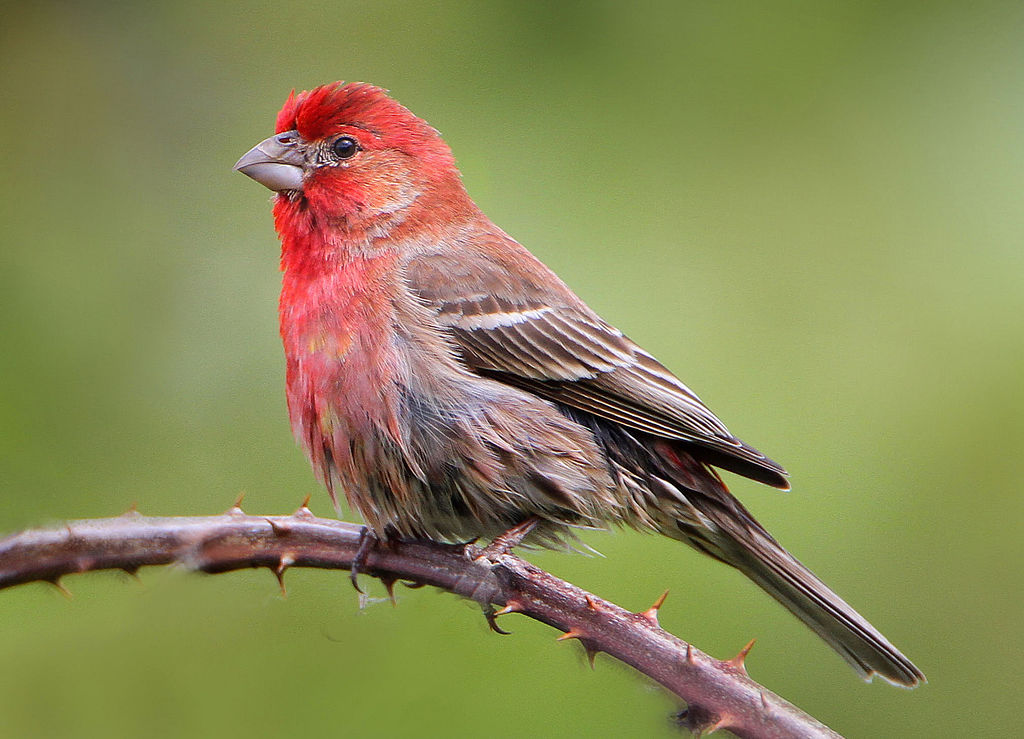
Coloration and Markings: Males are instantly identifiable, with gray and brown streaked backs, wings, and tails with white breast and underbelly. The breast has rosy-red streaking that deepens in color going up and facially, these birds are rosy-red with some gray around the eyes and occasionally some ‘zigzag’ marking from the back of the eye which bifurcates to go to the back of the neck and to frame the cheek. These birds have stout, slightly curved silver bills. Females lack the red coloration, being gray-brown instead with an unmarked face and thick streaking on the breast and back.
Size: These birds measure in at 5.1 – 5.5 inches in length with wingspans of 7.9 to 9.8 inches.
Habitat: House Finches get around, spending time at the forest’s edge, in farms, parks, and backyards.
Diet: The easiest and most effective lure for the House Finch is small or hulled Black Oil Sunflower seeds.
Supporting cast (Other Backyard Birds of Tennessee That Might Pay You a Visit)
In order to maximize your chances of spotting a new, beautiful species we’ve added a little bonus in the form of our ‘Supporting Cast’. These winged celebrities don’t get the feature space in the front of the article but they are well worth your time. Watch out for the following feathered friends:
- Mourning Dove
- Tufted Titmouse
- Eastern Towhee
- White-throated Sparrow
- Downy Woodpecker
Mourning Dove – Zenaida macroura
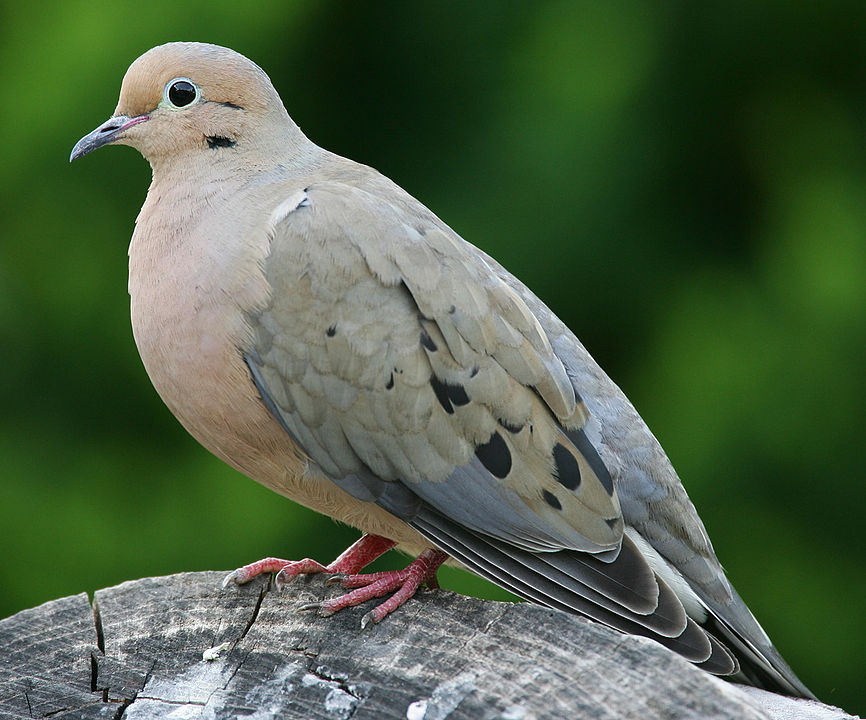
Coloration and Markings: Mourning Doves may have some regional variance in their plumage but typically they have largely tan back and wings with some gray and long gray and tan tails. The breast is creamy tan and white and this coloration whitens progressively as it moves down to the underbelly. Facially, the tan color is at its richest and a distinctive white eyering is present. This bird has a short, straight black bill.
Size: These Doves measure in at 9.1 – 13.4 inches in length with wingspans of approximately 17.7 inches.
Habitat: Fields, sidewalks, or simply scoping you out to see what you drop from the safety of telephone poles and wires, these birds are at home in just about any open area and will happily visit a backyard feeder.
Diet: Black Oil Sunflower seeds, wheat, cracked corn, and White Proso millet are all favorites of the Mourning dove that can lure them and keep them coming back for more.
Tufted Titmouse – Baeolophus bicolor
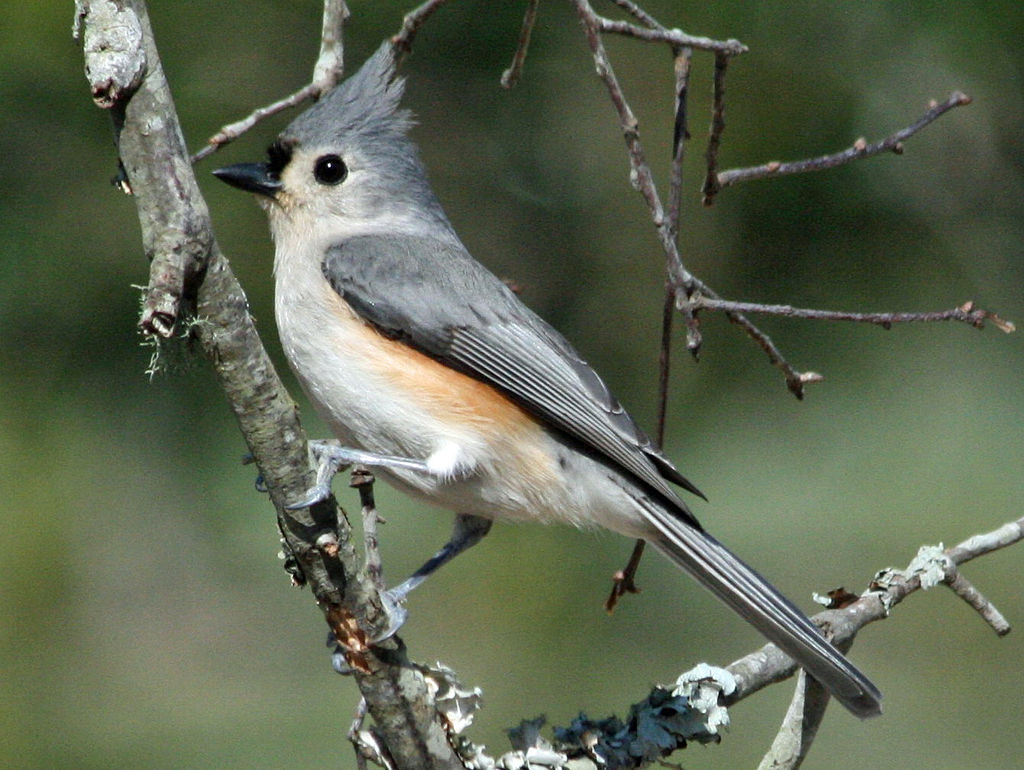
Coloration and Markings: The Tufted Titmouse has blue-gray back, wings, and tails with some minor black highlighting present. Their breast and underbelly are white with a flanking of peach color on the sides just under the wings. Facially, they have mostly white faces, being blue above the eyes and this blue fills their crest and extends in a line down the neck. The look is finalized by a distinctive black mark above the small, curved black bill.
Size: These birds measure in at 5.5 – 6.3 inches in length with wingspans of 7.9 to 10.2 inches.
Habitat: These birds frequent Evergreen and deciduous forest but they are also fond of parks, orchards, and backyards with welcoming treats.
Diet: The Tufted Titmouse loves Black Oil Sunflower seeds, peanuts, and suet, so stock up on these for your happy little winged friends!
Eastern Towhee – Pipilo erythrophthalmus

Coloration and Markings: Eastern Towhees are sharp looking birds, with black back, wings, and short black tails. Some minor white highlights will be present in the wings and on the underside of the tail. The breast and underbelly, by contrast, are largely orange-brown with white in the center and facially these birds are completely black, with a small black crest and stout but short conical black bills.
Size: These birds are 6.8 – 8.2 inches long with wingspans of 7.9 to 11 inches.
Habitat: These birds love the forest’s edge but they do explore other areas, preferring spots with dense vegetation. Brambles, thickets, and shrubs are all welcoming shelters for a foraging Eastern Towhee.
Diet: These birds love White Proso millet but you will want to scatter more of it on the ground that in the feeder for best results.
White-throated Sparrow – Zonotrichia albicollis
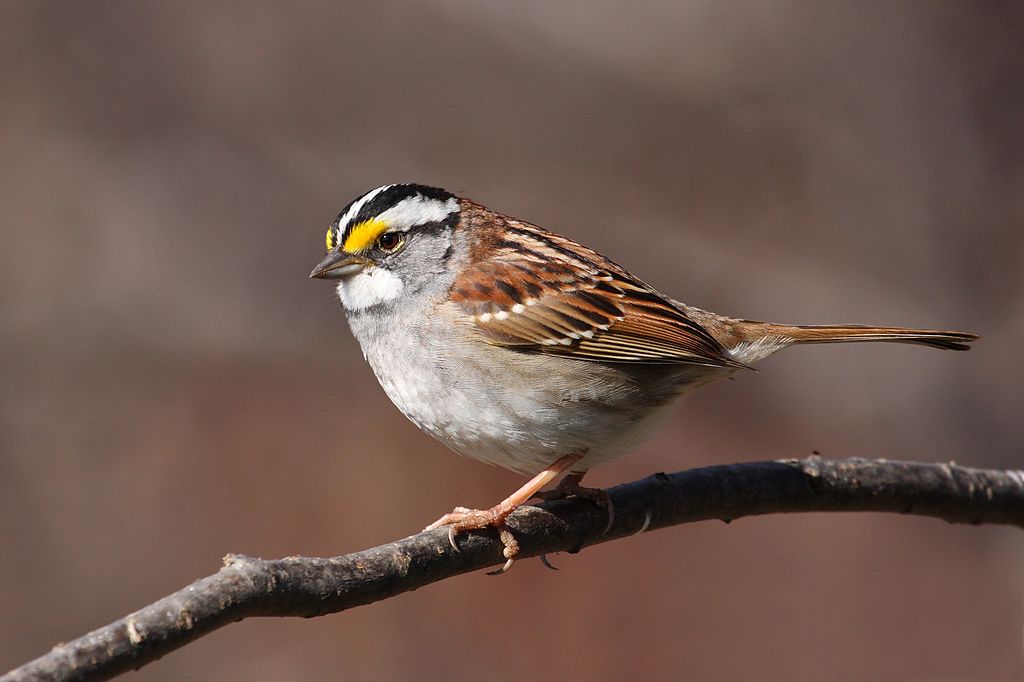
Coloration and Markings: White-throated Sparrows have brown back, wings, and long tails and there are 2 thin white wingbars present on each wing. Some tiny white highlighting is present on the tailfeathers and the beast and underbelly of this bird are white in the center but mostly gray from there to the sides of the bird under the wing. Facially, the bird has a gray face with a white throat, a very thin black maskline crossing the eye to the back of the neck and above this, a distinctive white eyebrow line that is yellow at itss fore-point in front of the eye. The top of the head is ‘skunk striped’, with mostly black present which is bisected with a white line at the top middle of the bird’s head. Sometimes you will see this bird and notice that the black has been replaced by brown on the ‘skunk cap’ portion of the head and these White-throated Sparrows are referred to as ‘tan-striped’.
Size: These birds measure in at 6.3 – 7.1 inches in length with a wingspan of 7.9 to 9.1 inches.
Habitat: These birds frequent the edges of ofrests but they are also fond of water, so you can sometimes spot them foraging close to ponds and in marshes. They aren’t shy, though, and often venture forth to visit fields, parks, and backyards in which to play and hunt for snacks.
Diet: White-throated Sparrows are happy with White Proso millet and/or Black Oil Sunflower seeds. Both is better but singly they are effective as well. It just depends on how much you want to spoil your new Avian friend.
Downy Woodpecker – Picoides pubescens
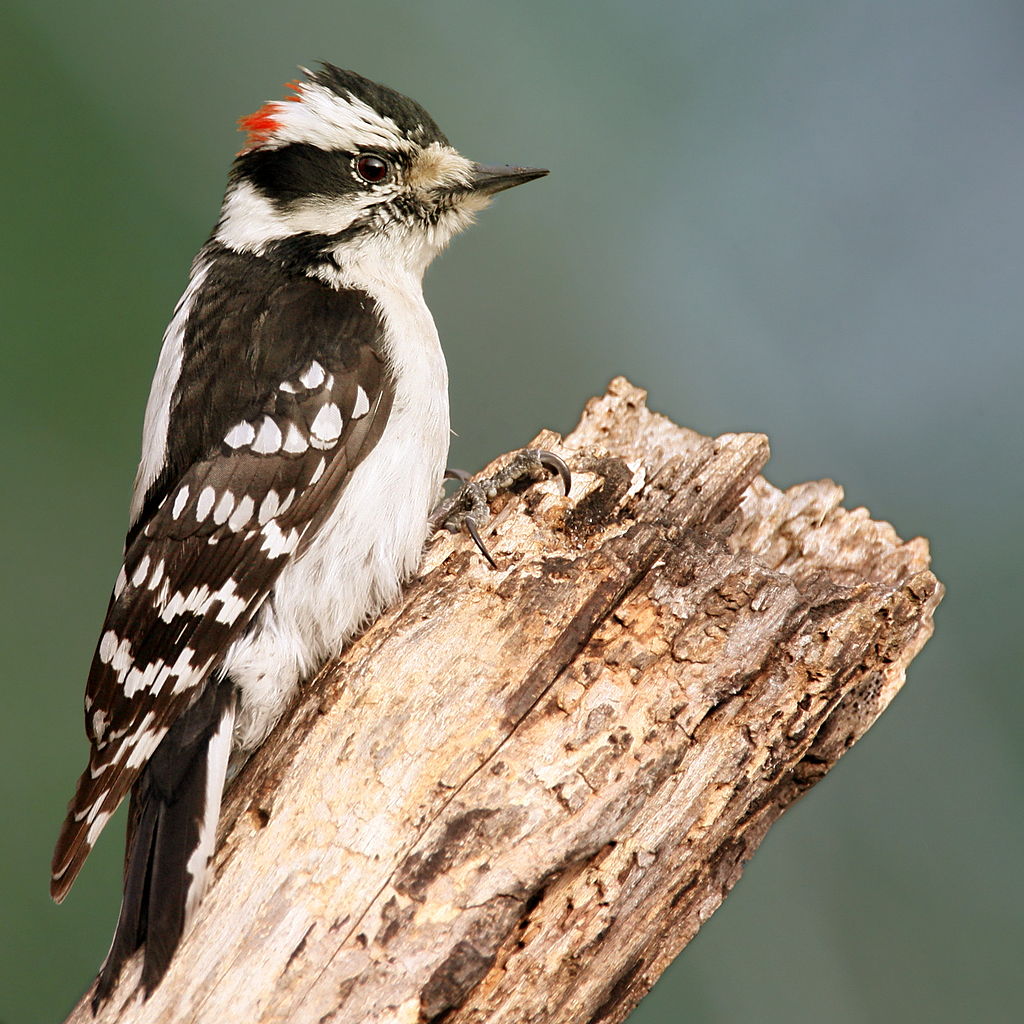
Coloration and Markings: These little guys are easy to identify. The Downy Woodpecker has a white back, with black shoulders and the rest of the wings being black with white square markings which create a distinctly checkered pattern. Their tails are short and black on top but white on the bottom and they have a paper white breast and underbelly, with the white continuing uninterrupted until it meets a black mustache line at mid-face level. The rest of the bird’s face is white with the exception of its black mask, it’s short, straight black bill, and the black cap on top of its head. In males, this cap terminates at a red mark at the back of the head. This bird has a short, straight black bill.
Size: These diminutive Woodpeckers measure in at 5.5 – 6.7 inches in length, which makes them somewhat of a ‘mini-Woodpecker’. They have wingspans of approximately 9.8 to 11.8 inches.
Habitat: These birds love any open area that has high weeds, thickets, brush, or shrub-cover to forage in. They are also happy to venture into backyards so you will want to be prepared if you’d like a closer look.
Diet: While suet is their favorite, these birds will also sup on other Woodpecker favorites like peanuts, Black Oil Sunflower seeds, and White Proso millet.
Tennessee Bird Buffet
When it comes to creating the ultimate ‘Tennessee Bird Buffet’ designed to attract the most local birds, we found some great advice from the Tennessee Wildlife Resources Agency to share. First and foremost, Black Oil Sunflower seeds are a single item that will attract the widest variety of local birds but you can also get great results with the following items:
- Cracked corn
- White Proso millet
- Wheat
- Oats
- Nyjer thistle
- Suet
- Peanuts
- Fruit
- Peanut butter pudding (see the Wildlife Resources link in our references)
Tennesseee Birding Hot Spots
The Chirparazzi advises that the best celebrity sightings and photos may be found at certain hotspots around the state of Tennessee. The next time that you feel like leaving the house for a little fresh air, check out one of these sites that we have provided. There are selections from Central Tennessee as well as one for each main compass point so it is likely that there is one close to you. Be sure to visit one of the following for relaxation and birdwatching excitement:
- Northern hotspot – South Carthage Rail Trail
- Eastern hotspot – Riverwalk Greenway (Pigeon Forge)
- Southern hotspot – Mountain Goat Trail
- Western hotspot – Wolf River Greenway
- Central hotspot – Murfreesboro’s Stones River Greenway System
Detailed descriptions of each location as well as information regarding visiting and what birds you can see at these locations may be found at https://www.traillink.com/stateactivity/tn-birding-trails/
Final Thoughts
That’s all the time that we have for today but we hope that you have enjoyed learning about the backyard birds of Tennessee. Be on the lookout, as there is many a bird in this state that you can spot without much difficulty once you know exactly where to look. Be it telephone poles, shrubs, or around certain trees such as Oaks or Evergreens, each bird has a favored location where they like to roost, forage, and play. Just keep your wits about you and with a little patience you’ll find some feathered delights which will amuse and amaze you. Happy birding, folks, we wish you the best!
